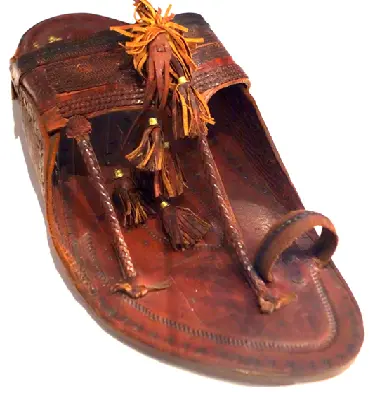
After public outcry, Prada acknowledged the design’s Indian roots, sparking a global conversation on cultural credit, artisan rights, and ethical fashion.(photo source-Wikipedia-Bata Shoe Museum, Toronto)
A Runway Revelation: When Kolhapuri Walked Milan
When Prada unveiled its Spring/Summer 2026 menswear collection at Milan Fashion Week, one accessory stood out, not for its novelty, but for its familiarity. The Italian fashion house showcased open-toe, braided leather sandals that bore a striking resemblance to Kolhapuri chappals, a centuries-old handcrafted footwear tradition from Maharashtra and Karnataka, India.
Initially labeled as “leather sandals,” the design’s uncanny similarity to Kolhapuris did not go unnoticed. Indian social media erupted with criticism, accusing Prada of cultural appropriation and failing to credit the artisans behind the iconic design. The backlash was swift and intense, especially given the sandals’ luxury price tag of ₹1.2 lakh (approx. $1,400), compared to the ₹300-₹1,500 range for authentic Kolhapuris in India.
Artisans, activists, and fashion commentators voiced their dismay. “This is not just footwear, it’s heritage,” said Laila Tyabji, chairperson of Dastkar. “To rebrand it without acknowledgment is to erase the very people who’ve kept this craft alive for generations.”
The Maharashtra Chamber of Commerce, Industry and Agriculture (MACCIA) formally wrote to Prada, demanding recognition and urging the brand to engage with local artisans. The letter emphasized that Kolhapuris hold a Geographical Indication (GI) tag since 2019, underscoring their cultural and economic significance.
Prada Responds: Acknowledgment After Outcry
Facing mounting pressure, Prada issued a statement acknowledging that the sandals were “inspired by traditional Indian handcrafted footwear made in specific districts in Maharashtra and Karnataka.” The brand emphasized its commitment to “responsible design practices” and expressed openness to a “meaningful exchange” with Indian artisan communities.
Lorenzo Bertelli, Prada’s Head of Corporate Social Responsibility, responded directly to MACCIA, stating that the sandals were still in early design stages and may not be commercialized. He also confirmed that Prada is open to future collaborations with Indian artisans.
While some welcomed the acknowledgment, others criticized the timing. “It’s disappointing that recognition only came after public outrage,” said Harsh Goenka, an Indian industrialist. “Our artisans make these by hand for ₹400. They lose, while global brands cash in on our culture.”
The controversy also sparked a wave of online activism. Hashtags like #KolhapuriChappals and #CreditIndianCraft trended globally, with users sharing side-by-side comparisons of Prada’s sandals and traditional Kolhapuris. Many called for stronger international protections for indigenous designs and artisan rights.
Beyond Fashion: A Cultural and Ethical Reckoning
The Prada-Kolhapuri episode is not an isolated incident, it’s part of a broader reckoning in the fashion world. From Gucci’s mislabelling of turbans to Dior’s use of Mexican embroidery, luxury brands have often walked a fine line between inspiration and appropriation.
What makes this case particularly poignant is the symbolic and economic weight of Kolhapuri chappals. These sandals are not just fashion statements, they are functional art, crafted by generations of artisans using techniques passed down since the 12th century. They represent regional identity, sustainable craftsmanship, and community livelihoods.
Legal experts argue that while international enforcement of GI protections is limited, the moral imperative is clear. “Brands must go beyond aesthetics and engage with the communities that inspire them,” said a senior intellectual property lawyer.
MACCIA has urged Prada to take concrete steps, such as collaborating with Indian artisans, offering fair compensation, and supporting ethical fashion practices that respect traditional knowledge. “This is an opportunity for Prada to lead by example,” said Lalit Gandhi, MACCIA President. “True luxury lies in authenticity and respect.”
Conclusion:
Prada’s Kolhapuri-inspired sandals have done more than stir a fashion debate, they’ve spotlighted the urgent need for cultural accountability in global design. As the world grows more interconnected, the line between homage and exploitation becomes thinner. But one thing is clear: heritage deserves more than a footnote. Whether this moment leads to lasting change or fades into the next trend cycle depends on what happens next. Will Prada walk the talk and empower Indian artisans? Or will this be another case of tradition rebranded without tribute?
Stay updated with the latest news on Rapido Updates. Keep yourself updated with The World, India News, Entertainment, Market, Automobile, Gadgets, Sports, and many more